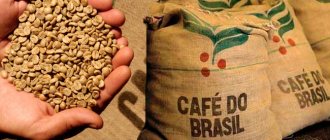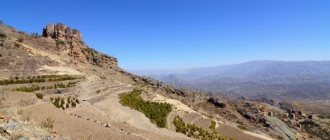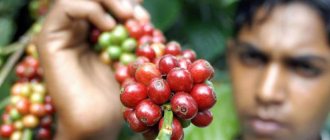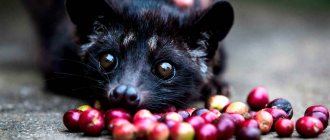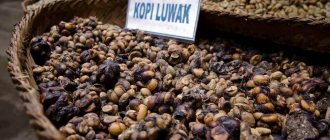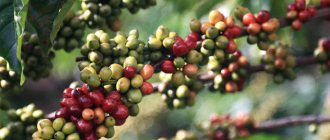A huge country, occupying more than half the area of the South American continent, is famous for its colorful carnivals, magnificent beaches, white pants, and great football players. And the Federative Republic of Brazil ranks first in the world in the supply of coffee to the world market. Every third cup of it drunk on the planet is made from grains grown on the endless plantations of the picturesque ecumene. The Brazil Santos variety is considered one of the best in Brazil and the world. Its classic taste is the standard for quality Arabica coffee. Let's find out how it is created.
Geographical features
The city has a very unusual geographical location - its streets surround the shores of a small bay indented by bays. Santos is partly located on two large islands, Guayao (port. Ilha Guayao) and Guaybe (port. Ilha Guaybe), partly on the mainland. Another part of it is located on the island of São Vicente (port. Ilha de São Vicente), which also contains the city of the same name (port. São Vicente).
The territory of the port city is crossed by 4 rivers flowing into the ocean: Cubatao (port. Rio Kubatao), Jurubatuba (port. Rio Jurubatuba), Passabusu (port. Rio Passabusu) and Bertioga (port. Rio Bertioga).
Because of this, many areas of Santos look like a little Venice.
Climate
The city of Santos is located in a humid tropical climate. Even during the driest period, there is a large amount of precipitation here. The driest month is August, and the most rainfall occurs in January.
The average annual air temperature in the area is +22°C. The warmest month is February with an average temperature of +25.2°C (max + 28.6°C); the lowest temperatures are observed in June, the average temperature at this time is about +18.8°C (at min + 14.7°C).
The average annual water temperature in the Atlantic Ocean off the coast of Santos is +23.8°C. February has the highest average water temperature (about +27.5°C); August marks the lowest temperatures, at which time they are around +20°C.
Historical reference
The beautiful port city, located in the picturesque bay of Bahia dos Santos, which has fertile lands, once attracted European settlers to the coast. The Indian tribes that inhabited these territories did not resist the alien invasion. Moreover, the aborigines even contributed to the settlement and development of the city.
Santos was founded by the Portuguese, led by Bras Cubas (port. Bras Cubas) on the island of Sao Vicente in 1546. The old part of the city is still located on the eastern side of the island, the new part is on the mainland. Until the middle of the 20th century. the city was one of the largest coffee trading centers in Brazil, thanks to which Santos became known in the world as the “Coffee Port”. Today, in the exchange building where the trading took place, there is a “Coffee Museum”.
Today Santos is a modern industrial, financial and tourist center, a major port of Brazil and a naval base, an outport of the city of Sao Paulo.
History of Brazilian coffee
Now ask any schoolchild what he knows about coffee, and you will get an instant answer: Brazil is the country of coffee. But we will try to dispel doubts about the origin of this plant.
Few people know that the coffee bush was brought to Brazil illegally, through intrigue, love and seduction of women. At the beginning of the eighteenth century, diplomat Francisco de Melo Palheta used all his charm to carry out the order of his government and bring a coffee tree to the territory of his country at all costs, and the governor’s wife could not resist Francisco’s charms, subsequently giving him the coveted bush .
So in Brazil they began to grow coffee for their own needs, and from the mid-eighteenth century the real coffee boom of Brazil began, exporting coffee to America and Europe. People quickly liked the beans, which had invigorating properties, and coffee production in Brazil gained unprecedented momentum. In the mid-twentieth century, Brazilian coffee accounted for almost 40 percent of total world production.
Due to the increase in industrial production volumes, workers were required. People began to migrate from all over the world to provide inexpensive labor, and the beginning of the twentieth century marked the second coffee boom in Brazil. It is known under the slogan Coffee with milk. It was on these two products that the country's economic growth was based.
During this period, the country processed an incredible amount of coffee, the market was oversaturated, the government was forced to increase the price of Brazilian coffee and banned exports to other countries until the price returned to its previous positions.
By 1920, Brazil had become virtually the only coffee-producing country, accounting for eighty percent of the world's coffee industry. But in the early fifties, other countries began to produce coffee no worse than Brazil, and foreign coffee gradually began to displace the main monopolist.
Tastes in coffee have changed, and a softer taste and refined aroma have become valued. Brazilian coffee, produced in huge quantities, began to suffer from competition. Other states demanded that export standards be reduced. Now Latin Americans are investing heavily in coffee production, which allows them not to lose their position and remain a leader in the coffee industry.
Sights of Santos
In Santos, a city founded in the 16th century, many historical and architectural monuments, many beautiful churches, and many museums have been preserved.
By Brazilian standards, Santos is a much calmer city than Rio or Sao Paulo. It is famous for both its pretty historical center facing the port and its beautiful beaches.
Tourists strolling through the pleasant green center with colonial buildings, cobbled squares, shady public gardens with cozy benches call Santos “little Paris.”
The city's many visitors enjoy a wide range of things to do and see. The city has many interesting museums: the Coffee Museum, the Maritime Museum, the Museum of Church Art, and the Fisheries Museum. Also in Santos there are several ancient churches open to the public, the Santo Amaro fortress, a beautiful botanical garden, and a wonderful city Aquarium with rare inhabitants of the depths of the ocean represented in it.
Coffee Museum
The highlight of any excursion tour, the most visited tourist attraction in the city of Santos is the Coffee Museum (port. Museu do Cafe). The museum is housed in a beautiful historical building, which once housed the Coffee Exchange (port. “Bolsa do Cafe”).
Many years later, the building, distinguished by its unique architecture, is a historical and architectural landmark in itself. The majestic ancient building has preserved beautiful stained glass windows and collections of rare furniture.
The Coffee Museum, which opened in 1998, is more than just a museum. Touching on the history of Brazilian coffee and the coffee evolution of the country, it is a kind of “coffee-local history” museum.
Here visitors can learn about the methods of preparing real Brazilian coffee. The next section of the exhibition focuses on the various attributes coffee farmers use to collect and process coffee beans. In one of the halls, visitors are told about the beginning of Brazil's coffee history: from 1875 to 1930. More than 2 million immigrants arrived in Brazil, almost half of whom were Italians. There were also a lot of Japanese.
A visit to the museum ends with a working coffee shop and souvenir shop. At the coffee shop you can enjoy a fragrant drink with a variety of pastries and purchase beans by weight. Among the souvenirs are decorations in the form of grains; various coffee-based cosmetics; sweets in the form of chocolate coffee beans.
Fisheries Museum
The Fisheries Museum is located at the very end of the eastern edge of the beach. It was located in a palace that previously belonged to the Nautical School. Even earlier, the main fort was located here, protecting the entrance to the port bay.
The collection of museum exhibits includes stuffed various commercial fish, giant squid and other strange marine life. But the highlight of the exhibition is the 23-meter whale skeleton.
Aquarium
Both children and adults will be interested in visiting the city Aquarium, where you can watch exotic colorful fish, see rare marine predators and inhabitants of the deep sea, striking with a truly fantastic view.
It is quite large: sharks, rays, moray eels and other local marine life swim in it. Penguins and seals are kept in a separate room.
Tourist tram
A unique symbol of Santos is the old tram “Linha Turística de Bonde” (from the port Tram Tourist Line), which the residents of the port city are extremely proud of.
The miniature green carriages have completely preserved the decoration of past times; you can even see old posters here. Rare trams run daily through the central part of the city with a guide, passing many interesting sights.
For those who want to explore all the most iconic places of Santos in a short time, this trip will be an ideal option.
Mount Monte Serrat
Among lovers of hiking, Monte Serrat is especially popular, on top of which there is a wonderful park where there are many beautiful places to relax.
The best way to get to the top of the mountain is by cable car, from which you can admire lush vegetation and breathtaking panoramic views of the city.
The ancient funicular, which rises to a height of 147 m above sea level, has been operating in its original form since 1927.
There are also several excellent viewing platforms at the top of the mountain. In addition, several historical attractions have been preserved here. So, during a walk you can see the old casino building and visit a small ancient church.
Fortress "Santo Amaro"
Excursions around the territory of the ancient fortress “Santo Amaro” are popular among history buffs. This fortress, built to protect the coastal area from the endless raids of conquerors, has been perfectly preserved to this day; even the massive walls surrounding it have survived.
During the tour, visitors are allowed to look into the most hidden corners; they can also climb the fortress wall and appreciate the view of the city from it.
Fish market
Perhaps one of the most famous places in the port city is the Fish Market (port. Mercado de peixe).
It is located close to the beach, opens early in the morning and sells a huge amount of seafood throughout the day. In addition to residents, the market buys fish restaurants, of which there are a great many in Santos.
Everything is simple here, there are almost no refrigerators, all the goods laid out on ice are guaranteed fresh. Anything that is not sold in a day is thrown away.
Santos Beach
Santos is a large seaside town with a long promenade and an excellent beach.
Here it becomes especially clear that Brazil is not in vain considered “the most football country”: the entire beach, almost 6.5 km long, resembles a single football field - football is played everywhere here, countless football teams train.
Municipal and state parks
There are many well-kept parks in the city and its surroundings, among which the following should be mentioned:
- "Parque Natural Municipal Nascentes De Paranapiacaba" is located 19 km from the city center;
- "Parque Estadual Restinga De Bertioga" - 32 km;
- “Parque Natural Municipal Da Cratera De Colônia” - 40 km;
- "Parque Natural Municipal Itaim" - 43 km;
- Parque Estadual Das Fontes Do Ipiranga - 43.2 km.
The symbol of the city
The ancient tram Linha Turística de Bonde is the original symbol of Santos, which even today is ready to give a lot of emotions and impressions. Its miniature size and finish retains all its original shape, as well as its original green color, straight out of a Brazilian poster. Such trams can be seen in the city center and in nearby places. This green transport is an excellent option for those who want to leisurely explore all the iconic sights and places of Santos.
Linha Turística de Bonde
Another place that can be found in the city surroundings is the Parque Ecológico Voturuá. It seems to be simply created for hiking and observing the fauna of Brazil. Little visitors will enjoy watching parrots, lions, monkeys, hippos, and turtles surrounded by nature.
Queimada Grande Island
69 km from the center of Santos there is a world-famous attraction - the ominous island of Queimada Grande (port. Ilha da Queimada Grande), commonly known as the “Snake Island”. For several hundred years, its main “residents” have been snakes.
Only according to rough estimates, about 5 poisonous snakes live per 1 m² of land in Queimada Grande. For this reason, even landing on the shore of an island infested with reptiles is considered mortally dangerous, not to mention walking along it.
The only building on the island is an automatically controlled lighthouse. There are many scary stories and legends about the creepy Snake Island. On Queimada Grande, a large number of people have indeed died in recent years, including fishermen, as well as the family of the lighthouse keeper.
However, the island still remains a center of attraction for researchers from all over the world who are willing to risk their lives in order to see with their own eyes one of the most dangerous places on the planet.
Football
In Santos, at the Urbano Caldeira Stadium (port. Estadio Urbano Caldeira), better known as “Vila Belmiro,” one of the most titled football clubs in Brazil, “Santos,” plays, where the “King of Football” Pele spent almost his entire career. There is a memorial dedicated to the club's outstanding players, led by Pele, at the stadium.
The stadium is named after Urbano Vilella Caldeira Filho (port. Urbano Vilella Caldeira Filho; 1890-1933) - an outstanding Brazilian football player, goalkeeper (1913-1917), coach (1913-1932) and head of the Santos club.
Every year on January 9, his birthday, the club organizes a celebration called "Urbano Caldeira Day". The stadium has never been one of the large arenas; its capacity is only 16,798 spectators. Meanwhile, in September 1964, an absolute record for the number of fans was set - 32,986 people were present at the match between the Santos and Corinthians Paulista clubs.
Taking into account the fact that Santos is one of the most titled and Brazilian teams, the management of the football club periodically has plans to build a more spacious stadium corresponding to the status of Santos. In addition, this would save the club from having to regularly rent stadiums in Sao Paulo.
Interesting Facts
Brazilian plantations, which are small in size in keeping with Latin American traditions, are owned by farming families and contain 4.5 million trees.
The appearance and taste of Santos beans varies and depends on the trees from which the fruit is harvested. The older the tree, the more standard and cheaper the grain. The Bourbon Santos variety, named after the island of Rounion renamed Bourbon by Louis XIII, is harvested from young trees no older than four years. The grains are small, often deformed, and cost twice as much as the larger ones that grew on old trees and only because of this they belong to the Flat Beat Santos variety and are valued less.
In Brazil, unlike Costa Rica or Guatemala, they grow not only Arabica, but also Robusta, which makes up 17-20% of the total crop, purchased by European restaurants and bars for espresso.
Santos Yellow Bourbon - ripe berries are yellow in color, not red like most other Arabica varieties.
Farmers sell coffee beans already roasted, or even ground. Brazilians often add aromatic seasonings to ground coffee to deepen the taste and add a spicy aroma.
On the Santos packaging there is a screenshot of one bean so that the coffee drinker gets an idea of the size and shape of the beans, and the processing method is indicated - wet or dry. Washed Arabica usually costs more.
Famous natives of the city
Born in Santos, Brazil:
- Waldemar Esteves da Cunha (port. Waldemar Esteves da Cunha; 1920-2013) - until his death, he was the oldest King Momo in Brazil (port. King Momo). "King Momo" is an image of the carnival king in some Latin American countries, most often used in Brazil and Colombia. Momo's appearance marks the beginning of the carnival celebrations. Each carnival has its own King Momo.
- Jose Macia (port. Jose Macia; born 1935), better known as Pepe (port. Pepe) is a former Brazilian football player and coach. He played in 40 matches for the Brazilian national team.
- Gilmar dos Santos Neves (port. Gylmar dos Santos Neves; 1930-2013), better known simply as Gilmar (port. Gilmar) - Brazilian football player, world champion in 1958 and 1962; the best goalkeeper of Brazil of the 20th century, one of the best goalkeepers in the history of world football according to the International Federation of Football History & Statistics (IFFHS). Most of his club career was spent in two great Brazilian teams - Corinthians Paulista and Santos.
Types and varieties of Brazilian coffee
There are not so many types of coffee around the world, so coffee plantations in Brazil are planted with Arabica and Robusta, which are familiar to us, in a ratio of 80:20. The influence of the first violin of the coffee business is so great that if the harvest decreases, the cost of coffee around the world will increase, despite the yield in other countries.
Kinds
Espresso is mainly made from Brazilian coffee. The types of coffee are affected by the area of cultivation, Arabica varieties, the size and color of the fruit itself, and the parameters of the richness of taste and aroma.
Brazilian coffee, the best varieties
The diversity of Brazilian coffee varieties does not in any way affect the sustainable cultivation of only two types - Brazilian Arabica and Robusta, and the more capricious Arabica is grown by a significant margin more than the primitive Robusta. For Arabica beans, elevated areas with a dry climate are preferred so that the beans are harder.
Coffee beans contain a small amount of caffeine, but they have a unique aroma that robusta is incapable of. Robusta grows in low bushes in low-lying areas of the country, but its beans contain more caffeine, making it ideal for an invigorating morning drink.
Quality control is carried out at every stage of harvesting and processing, right up to packaging. Since Brazil has many competitors, and quite justified ones, Brazilian manufacturers have no right to make mistakes in quality. And every year the quality of products is valued more than quantity.
It is not possible to single out the best type of coffee, since experts have divided their opinions, but we will try to present the line of the most popular varieties as follows.
- Brazil Santos coffee is the most popular variety of Brazilian coffee. It consists of several varieties, combining all the delicacy and delicacy of the drink. In regular sales you can find Santos coffee of the fourth grade. The first grade is more the exception than the rule.
- Maragogyp coffee is a combination variety with large beans.
- Brazil Iponema Rubi - This coffee grows in the highest mountainous areas and is popular in Latin American countries.
- Brazil yellow bourbon is a gourmet find, produced in its pure form.
- Brazil mogiana coffee is a type of specialized variety that has a fine line between sweetness and sourness.
Coffee Santos
This variety ranks first in popularity due to its taste and affordable price. It is a descendant of the old Arabica and grows mainly in the south.
Variety Minas
It has a specific smell due to the soil on which it grows, it is used in blends, it is not considered as a single variety, and it has a tart taste.
Maragogyp
It is distinguished by its large fruit size. Ambiguous expert opinion. But he did not leave anyone indifferent. It has a rather rough taste.
Variety Paransky
In the line of varieties of Parano coffee (and there are seven of them), the fifth is the most sold. This variety is not as high quality as the previous ones, but it is much cheaper. Paransky is named after the name of the port. Many varieties are named after the area in which they are grown, and the Paranan variety is no exception. Brazil even named the coffee brand brazil, after the entire country.
Curious facts
- The port of Santos is the largest in South America, its berth length exceeds 20 km.
- Santos is famous for its fertile area, in which one of the best varieties of coffee is grown - Bourbon, which has a refined sweetish-bitter taste with a slight sourness.
- The port of Santos is located in the bay of the same name on the Atlantic Ocean. The harbor is located in a strait between 2 islands and is accessible to ships with a draft of up to 13.5 m.
- Fishing is prohibited in Santos Bay. The point is not even that the port’s waters are polluted, but that 10 years ago there was serious contamination with mercury from one of the sea containers. Local fish still contains mercury. Therefore, what is officially sold on the local market is not local.
- Santos is now actively promoting the opportunity to visit the Coffee Museum at night. Like, for example, the traditional Moscow “nights at the museum”.
- Pele (port. Pele), full name Edson Arantes do Nascimento (port. Edson Arantes do Nascimento), is listed in the Guinness Book of Records as the author of 1279 goals in his football career. The legendary Brazilian forward played for the Santos football club from 1956-1974.
- The city is famous for the fact that the famous Brazilian architect Oscar Niemeyer (port. Oscar Ribeiro de Almeida de Niemeyer; 1907-2012) took part in the construction of some of its buildings.
- Many residents of Sao Paulo, upon retirement, sell their homes in the metropolis and move to Santos. Life in Santos is slower, safer and has a huge “bonus” in the form of the ocean.
[1]
Getting to know the city
Brazilian Santos is famous for its natural wealth, which has allowed the cultivation of the best coffee varieties - Bourbon. Coffee lovers know this refined, sweetish-bitter taste with a slightly oily undertone and slight sourness.
Santos is a wonderful town where you can hide from the bustle of everyday life. Many Brazilians move to Santos upon retirement, changing apartments in the stuffy metropolis. This city attracts with its regularity and safety, as well as the ocean nearby.
The local population numbers over 418,288 people. An important role in the economic life of the city is played by maritime trade, the export of coffee, soybeans, fruits and products made from them.
Well, how can we not mention the most titled football club in Brazil, Santos, where the legendary Pele played until 1974!
Getting to know the city
